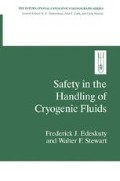Abstract
Safety is not an exact science but an ongoing process of improving, developing, and applying new knowledge. As new projects stretch the frontiers of technology (involving new or different experimentation and testing), new safety needs will be disclosed. This occurred, for example, when the decision was made to use liquid hydrogen as a rocket fuel and again when slush hydrogen was planned for use in the National Aero-Space Plane. Each new project involves safety needs that have many features in common with those of other projects, but usually it has needs unique to that specific project.
Access this chapter
Tax calculation will be finalised at checkout
Purchases are for personal use only
Preview
Unable to display preview. Download preview PDF.
References
Stewart, W. F., Dewart, J. M., and Edeskuty, F. J. (1990). Safe venting of hydrogen, in Hydrogen Energy Progress VIII (T. N. Veziroglu and P. K. Takahashi, eds.), Vol. 3, pp. 1209–1218, Pergamon Press, Elmsford, New York.
Witcofski, R. D., and Chirivella, J. E. (1984). Experimental and analytical analysis of the mechanisms governing the dispersion of flammable clouds formed by liquid hydrogen spills, in Proceedings of the World Hydrogen Energy Conference IV (J. N. Veziroglu, W. D. Van Vorst, and J. H. Kelley, eds.), Pergamon Press, Elmsford, New York.
DeSteese, J. G., and Counts, C. J. (1982). Liquefied Gaseous Fuels Safety and Environmental Control Assessment Program: Third Status Report, Battelle Pacific Northwest Laboratory, Report PNL-4172 UC.11, Richland, Washington.
Dodge, B. F. (1944). Chemical Engineering Thermodynamics, McGraw-Hill, New York, pp. 297–298.
McCarty, R. D., Hord, J., and Roder, H. M. (1981). Selected Properties of Hydrogen, NBS Monograph 168, U.S. Government Printing Office, Washington D.C.
Zabetakis, M. G. (1967). Safety with Cryogenic Fluids, Plenum Press, New York.
Stamps, D. W, Benedick, W. B., and Tieszen, S. R. (1991). Hydrogen-Air-Diluent Detonation Study for Nuclear Reactor Safety Analyses, Sandia National Laboratories Report NUREG/CR-5525, SAND89-2398, Albuquerque, New Mexico.
Sherman, M. P., Tirszen, S. R., and Benedick, W. B. (1989). Flame Facility, the Effect of Obstacles and Transverse Venting on Flame Acceleration and Transition to Detonation for Hydrogen-Air Mixtures at Large Scale, Sandia National Laboratories Report NUREG/CR-5275, SAND85-1264, Albuquerque, New Mexico.
Parrish, W. R. (1985). Sampling and analysis, in LNG Measurement, A User’s Manual for Custody Transfer (D. B. Mann, ed.), Section 2.2, U.S. Department of Commerce, National Bureau of Standards, NBSIR 85-3028, Boulder, Colorado.
Parrish, W. R., Arvidson, J. M., and Labecque, L. R. (1978). Development and Evaluation of an LNG Sampling Measurement System, U.S. National Bureau of Standards, NBSIR 85-3028, Boulder, Colorado.
Lee, R. E. (1952). The Explosiveness of Solid Oxygen in Liquid Hydrogen, Cambridge Corp. Technical Memorandum No. 19, Boulder, Colorado.
Cook, M. A., and Udy, L. L. (1962). Detonation Pressure of Liquid Hydrogen/Liquid Oxygen, Final Report for Contract No. NAS8-5058, George C. Marshall Space Flight Center, National Aeronautics and Space Administration, Huntsville, Alabama.
Plaster, M., McClenagan, R., Phillips, M., Benz, F. J., and Ullian, L. (1988). Detonation Properties of Liquid Hydrogen and Liquid Oxygen, Proceedings of the 1988 JANAF Safety and Environmental Subcommittee Meeting, Chemical Propulsion Information Agency Publication 485, Johns Hopkins University Physics Laboratory, Laurel, Maryland.
Arthur D. Little, Inc. (1961). Final Report, Electrostatic Hazards Associated with the Transfer and Storage of Liquid Hydrogen, Report to the Agena and Centaur Systems Office, Marshall Space Flight Center, National Aeronautics and Space Administration, Huntsville, Alabama.
Cassutt, L., Biron, D., and Vonnegut, B. (1962). Electrostatic hazards associated with the transfer and storage of liquid hydrogen, in Advances in Cryogenic Engineering (K. D. Timmerhaus, ed.), Vol. 7, pp. 327–335, Plenum Press, New York.
Willis, W. L. (1966). Electrical conductivity of some cryogenic fluids, Cryogenics 6 (October), 279.
Mann, D. B., Ludtke, P. R., Sindt, C. F., Chelton, D. B., Daney, D. E., and Pollack, G. L. (1965). Characteristics of Liquid-Solid Mixtures of Hydrogen at the Triple Point, U.S. National Bureau of Standards Report 8881, Boulder, Colorado.
Daney, D. E., and Mann, D. B. (1967). Quality Determination of Liquid-Solid Hydrogen Mixtures, U.S. National Bureau of Standards Report 9701, Boulder, Colorado.
National Fire Protection Association (1993). Standard for Gaseous Hydrogen Systems at Consumer Sites, NFPA 50A, National Fire Protection Association, Quincy, Massachusetts.
National Fire Protection Association (1993). Standard for Liquid Hydrogen Systems at Consumer Sites, NFPA 50B, National Fire Protection Association, Quincy, Massachusetts.
Author information
Authors and Affiliations
Rights and permissions
Copyright information
© 1996 Springer Science+Business Media New York
About this chapter
Cite this chapter
Edeskuty, F.J., Stewart, W.F. (1996). Safety Problems Needing Further Investigation. In: Safety in the Handling of Cryogenic Fluids. The International Cryogenics Monograph Series. Springer, Boston, MA. https://doi.org/10.1007/978-1-4899-0307-5_12
Download citation
DOI: https://doi.org/10.1007/978-1-4899-0307-5_12
Publisher Name: Springer, Boston, MA
Print ISBN: 978-1-4899-0309-9
Online ISBN: 978-1-4899-0307-5
eBook Packages: Springer Book Archive

